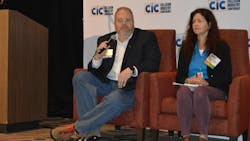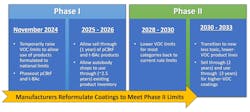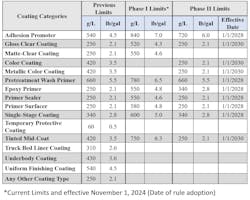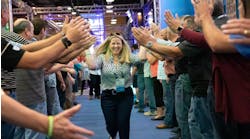It may seem like a step backward, but VOCs for automotive refinish coatings in southern California are becoming higher, not lower, at least for the short-term. That’s because although volatile organic compounds (VOCs) cause ozone and smog, the low-VOC solvents currently used are suspected carcinogens.
The Collision Industry Conference in January in Palm Springs, California, held a session to discuss the November 2024 change to Rule 1151 for the South Coast Air Quality Management District (SCAQMD.) SCAQMD serves the California counties of Los Angeles, Orange, Riverside, and San Bernardino, an area of about 11,000 square miles. Rule 1151 covers all motor vehicle and mobile equipment non-assembly line coating operations, and the proposed rule change, which was unanimously passed in November, will ultimately require product reformulations for many of the products.
Heather Farr, planning and rules manager for SCAQMD, said during the presentation that the California Office of Environmental Health Hazard Assessment has deemed tert-Butyl-acetate (TBAc) and para- chlorobenzotrifuloride (pCBtF, also known as Oxsol) as potential carcinogens.
“In the South Coast (AQMD) there are over 3,000 body shops. They’re sometimes clustered right in our communities. So, having this carcinogen in our community is the reason we took the approach we took in this role.”
As she explained, the area covered by the SCAQMD historically has had the worst air quality in the country. Nitrogen oxide emissions from incomplete combustion from automobiles, factories, and refineries mix with VOC emissions, such as from paints and coatings in collision repair shops. The energy from the sunny climate reacts to create smog, and the mountains that surround the region trap the pollutants.
“That’s why we try our best to get as low emissions as we can to try to clean up the air, but it’s a very big task.”
To meet VOC limits, she said, some products can use waterborne formulations, while others, such as clearcoats or solvent-borne basecoats, have historically used exempt solvents. Those exempt solvents are not photochemically reactive and thus do not produce a lot of ground-level smog. PCBtF has been exempt since 1995, she said, while TBAc has been exempt since 2005.
Phase I of phasing out PCBtF and TBAc, which began November 2024, temporarily raises VOC limits to allow the use products that are formulated to National Rule limits. It does provide for the “sell-through” from manufacturers and distributors for one year of products with those solvents and allows shops to use the same through mid-2026. Phase II begins in 2028, with lower VOC limits returning for most categories. The higher VOC products are allowed to sell through 2030 and use through 2033.
How specialized products meet local needs
Co-chair of the CIC Parts & Materials Committee and panelist Jeff Wildman, BASF Automotive Refinish Coatings automotive aftermarket expert, confirmed BASF produces different products for different locations across North America as well as globally.
“We try to standardize those as much as possible, but we have to meet the local regulations,” he said. “So as we see the changes coming in South California, we will have different products coming in. And for Phase One, we're going to be able to use products that exist in other markets today. So whether it be other parts of North America or some of those that are coming from Europe, we'll bring those in for just Southern California. For Phase Two, that's going to be all new products, that's new R&D.”
As new products and technology are developed, they will become available in other markets, also, “assuming they meet all the regulations,” Wildman said. “And that’s why when Heather said she’s talking with other air quality districts, as a paint company, we really like to hear that. Because a year ago, we had two different regulations in North America. Starting now, we’re going to have three. Hopefully, we don’t end up with a dozen as other air quality districts look at these rules and take pieces and parts.”
Farr said her department, through its public discussions, workshops, and meetings, which included paint manufacturers among its stakeholders, had considered a realistic timeline in how long it would take for new formulations to be complete. It also considered costs, which are expected to be less expensive for National Rule coatings used in Phase I. Meanwhile, costs to manufacture will rise and be passed along to end users for the new low-VOC formulations in Phase II.
Those costs, Wildman pointed out, could be spread out if there were more standardization for limits.
“We’d really love to do that with all air quality districts,” Wildman said. “And what would be even better is if we had a national program. And that's why as a global manufacturer, we also look at what's happening globally. And from a health and safety issue as far as sustainability goes, that's a huge topic in Europe. We're developing products there that we want to be able to use here.”
He pointed out that waterborne coatings are required only in limited areas throughout the country, but customers nationwide who are not required to use it do so often because they’re looking for a product that’s a bit more environmentally friendly.
“But we also have people that across the US using low VOC products today because they're looking for that product that in most cases it's better for the health of their employees. They're looking out for the health and safety of their own teams….That's why when we develop some of these new products, we try to develop product a great product they can use everywhere. Because it's not just better for us; it's better for our customers, for the neighborhoods, for everyone around.”
What is changing, and what’s the same
Gene Lopez, director of development and training for Seidner’s Collision Centers, said the transition for Phase I will be easy for painters.
“We're going back to late ‘90s technology, 20 year old technology. There could be some issues around the equipment that we’re currently using, with some of the spray gun technology. It's not a real big deal, but painters will have to relearn, so to speak, how to use the higher VOC limits. And a lot of people will be very happy, because that material was really easy to spray because they had been used to it for quite some time. So using this material could be joyful, but 2030 isn’t far away.”
Jason Scharton, Global Industry Relations Leader for 3M Collision and a panelist on the discussion, talked about how the personal protective equipment (PPE) that is effective against both low- and higher-VOC solvents have been in place for a couple decades.
“It already protects against inhalation and exposure to these two chemicals and all sorts of other ones. So, there’s no need to change. But it does bring the fact to the front that we need to use the PPE we have today.”
It’s more than lung protection that’s needed, he said. “We need to make sure we’re using our paint suits and our gloves, and eye protection, that we’re properly using our PPE and we’re covered the way we need to be.”
Scharton added that 3M has a call center for respiratory protection that can aid in respirator selection, how to select a filter cartridge, and more.
How compliance is enforced
Society of Collision Repair Specialists Executive Director Aaron Schulenburg, who moderated the panel, asked how the use of certain products is monitored and enforced. Farr said a team of inspectors visits local shops to trace where a noncompliant product came from.
“And that's just one more thing that makes this difficult, Wildman said, “because every distributor out there in Southern California doesn't just serve the South Coast Air Quality district. They serve customers in other areas. And the manufacturers and warehouse distributors serve other areas and training centers serve customers coming from different areas. So it's a very complicated process to make sure that the right product goes to the right shop at the right time. There's a lot of logistics management that goes into implementing and ensuring that we are following all regulations.”






